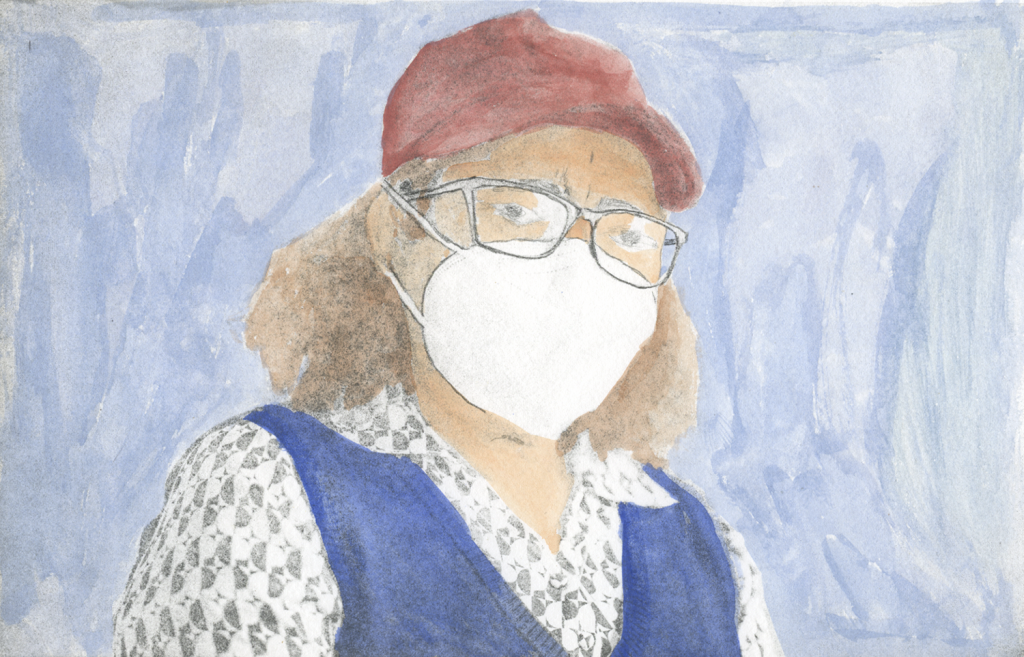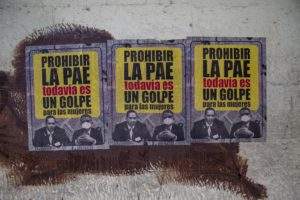According to data from the Ministry of Justice [Ministerio Público – MP], more than 3,037 women have been reported missing in Honduras in the last 12 years. There is little information about the status of these missing person cases, but what data exists reveal that the missing women may have been victims of crimes such as human trafficking, kidnapping and commercial sexual exploitation. In the absence of information and investigation protocols, women around Honduras have banded together to keep up the search and pressure institutions for answers so that the disappeared are not forgotten.
Illustrations by Margarita Figueroa
Charts by Carmen Quintela/ Agencia Ocote
Translation by: John Turnure
Families who report missing women in Honduras first turn to Martha before they notify the appropriate authorities.
When Martha is not selling fruits and vegetables, she works with her community’s committee of families of disappeared migrants. She has been a member of this committee for the last 20 years, in a village in the central Honduran department of Francisco Morazán. She often works with women who have lost contact with family members migrating north, but has also helped in cases of women who are victims of other crimes, such as human trafficking.
We interviewed Martha outside her home. She’s afraid to talk publicly about the cases she has been involved in, so we are not using her real name in this article. “Sometimes I feel very psychologically damaged because this isn’t easy. I’ve had some very tough cases that I can’t even tell my family about because I can’t involve them,” she says, almost whispering when her granddaughter quietly walks in on the interview. She asks someone to take her granddaughter away because she doesn’t want her to hear the stories she’s telling us.
Martha has searched for abducted women, victims of human trafficking, and victims of commercial sexual exploitation. She has been threatened because of this, and says she doesn’t feel safe reporting this to the authorities.
“I sometimes wish I could just do the whole search on my own. Once in a while, I give them [the authorities] all the information needed to locate the victims, because sometimes we’ll receive clues as to where they are. But not even that [helps],” says Martha. So far, she has worked on about 70 cases of women who have gone missing from her community.
The government of Honduras doesn’t talk about disappearances. There’s no specific institution that deals with this issue, and all missing persons reports are filed with the Attorney General’s office and the Honduran National Police [Policía Nacional de Honduras – PNH].
MP data indicate 3,037 women were reported missing from 2008-2019. Yet there is little information on how these cases are proceeding. “We cannot provide you with information on the status of these cases because they are under investigation and are therefore confidential,” wrote the MP in response to Contracorriente’s information request. The MP spokesperson declined to be interviewed on the subject.
The PNH’s records and the struggle against stereotyping
Women are frequently blamed for their own disappearances. The Women’s Forum for Life [Foro de Mujeres por la Vida], a group of organizations that tracks cases of violence against women (domestic violence, femicides and disappearances), reports that they have uncovered cases that the authorities refuse to investigate.
In some places, it’s normal for girls, even minors, to leave home with an adult who claims to be their partner. That’s what happened in one of the cases tracked by the Forum. “This now seems to be the norm. Even though the girl’s mother and father reported that [the man] had taken her and that she’s not the first girl he’s taken, various agencies said that they couldn’t do anything because she left of her own free will,” says Karol Bobadilla, a representative of the Women’s Forum for Life.
This crime was defined in the 1983 Penal Code as kidnapping, and is punishable by three to six years in prison. The new Penal Code that took effect in June 2020 does not even mention this crime or anything of the like. From 2009-2019, 285 kidnapping cases were presented to the courts. Almost all of the accused were men and almost all of the victims were women.
Bobadilla says that even when they have information about a victim’s whereabouts, the police have refused to investigate. “We found out that a girl was in a village in the department of Santa Barbara, and the police didn’t want to do anything. We filed formal charges and the girl still hasn’t returned, even though her whereabouts are known. The parents and other family members have wanted to go see her, but she won’t say anything, she keeps quiet. They [the police] say that since she doesn’t say anything, she must want to stay there. These are the kinds of roadblocks we run into. As an institution, we can’t just go and break into someone’s house,” she says.
The PNH’s records of missing persons cases from 2011-2020 reveal that most involve minors. Cases containing information from relatives about what they thought had happened to the missing women usually involved suspicions that they had left with a partner, in many cases an older man.
The PNH database contains 383 cases of missing women reported between 2011 and April 2020, most of them in the department of Francisco Morazán. All of the cases appear as active in the database, with start and end dates corresponding to when the case was entered into the system. The data also indicate that most were 13-17 years old when reported missing.
One of the cases in the PNH database reports the following facts. “The person making the missing person report states that on February 4, 2016 at 7:30 pm: ‘I was in my house, when my daughter xxxx, 13 years old, went out to buy groceries. My other daughter, 10 years old, told me that the last time she saw her she was with xxxx, a young man, 22 years old, that my daughter was in love with. I haven’t heard from her since, so I am filing this report today, February 6, 2016 at 12:07 pm for investigation.’”
Of the 2,671 missing persons cases worldwide filed with Interpol as of the date of this publication, 444 pertain to Honduran women. These global police alerts are known as Yellow Notices, and are published for victims of parental abductions, criminal abductions (kidnappings), or unexplained disappearances.
Contracorriente contacted Police Commissioner Héctor Caballero Velásquez, the head of Interpol Honduras and also an officer with Honduras’ police investigations unit [Dirección Policial de Investigación – DPI] to determine how missing persons reports are received and why there is no information about the progress of these cases, but he did not respond.
They created their own missing persons search protocol
The inadequate information in the missing women reports gives no clues as to the causes of the disappearances. The only protocol that currently exists for reporting disappearances in Honduras is the Amber Alert, which is only used for locating abducted or missing minors. The Amber Alert law was approved in 2015, but still hasn’t been implemented because no detailed regulation has been developed yet to guide the implementation.
The lack of a protocol is an obstacle for Martha, since the police are the only ones who receive missing persons reports, and these are rarely pursued. This has led families to conduct their own searches for the missing women. Martha explains that when they know for sure that a woman has left Honduras to migrate north, they sometimes are able to locate them with the help of organizations in other countries. But she has also handled cases where women are deceived by job offers in Honduras that turn out to be commercial sexual exploitation or labor exploitation.
Information from the National Institute of Statistics [Instituto Nacional de Estadísticas – INE] indicates that 64% of the people in Martha’s community live in poverty, and most work in agriculture and raising livestock. Martha sells fruits and vegetables from a stand in front of her house, but has not been able to do this since the COVID-19 pandemic quarantine began. Many families are just trying to survive amidst a deepening economic crisis.
Most of the missing women reports filed with the prosecutor’s office are in the northern part of the country. The MP recorded 1,216 cases in the department of Cortés alone, while all the other departments don’t even amount to half that number.
The Women’s Forum for Life is located in the San Pedro Sula area. It’s one of the country’s most experienced organizations regarding disappearances, and its most well-known case is Norma Hernández, who disappeared in 2010. Norma belonged to one of the Forum’s member organizations. She was breastfeeding her 40-day-old daughter when several armed men wearing balaclava masks took her, claiming that they were acting on MP orders.
No one knows what happened to her, but the various failings in the official investigation into this case led the Women’s Forum for Life to develop its own protocol to address the cases of forced disappearance of women. The protocol is named after her, and they hope that one day it will be officially approved and used by the appropriate authorities.
The protocol document enables an analysis of whether a woman’s disappearance is connected to her gender. It also provides guidance on what action to take regarding the potential crime, how to report it, and what information the report should include. The document describes the legal actions and investigations authorities should undertake, especially if the woman is found dead or has not been found, as well as how they should treat family members to avoid re-victimization.
Karol Bobadilla explains that in Honduras, “there is no institution or special prosecutor that focuses exclusively on the disappeared, unlike other countries that do have specialists focusing on these types of cases and know from the start how to proceed, how to investigate when a person comes in to report a missing relative. Most cases here are spread across several institutions that apply pretty vague investigative procedures.”
Bobadilla also notes that re-victimization is one of their biggest problems in these cases. “Norma’s sister had to provide the same testimony four times because the prosecution misplaced it. Then, when a suspect in the case was arrested last year, the family had to re-live everything to document again what happened.”
She adds that there is a gap in Honduran law that was identified as a result of this case, because Norma had minor daughters when she disappeared. “In missing persons cases, there are no procedures in [Honduran] civil law to assign custody or guardianship of minor children, or to determine payment of life insurance. The only option is to declare that the missing person is presumed dead, which leads to re-victimization. Some countries like Mexico have a special law that establishes a different protocol for these cases, because being declared missing is like a different civil status,” she explains.
Human trafficking networks – a major risk for women
The inequality and poverty that exists in most Honduran communities pushes many women to migrate north, and they often disappear along the way. Sometimes they are tricked by deceptive job offers and end up as victims of commercial sexual exploitation or labor exploitation.
“We had a chance at saving one young woman. (The traffickers) already knew everything about her, and came looking for her after she escaped. They were tracking her down, but I don’t know what has happened since then. The family might be afraid to tell me where she is, and will only say that she’s in hiding. I know others haven’t been able to escape this human trafficking network,” says Martha.
Martha explains that she has helped the family members of women who were being held in Tegucigalpa by traffickers who recruited them from nearby communities with offers of work. “Once they get there, the women are prostituted. Times are tough all over the country, and parents will often let their daughters leave to find work. Sometimes, it turns out that what [employers] want is to sell them. There’s a lot of that around here,” she says.
Although there is no official information on investigations into cases of missing women, other criminal cases sometimes involve a prior or temporary disappearance of the victim. Information from the MP compiled by the Women’s Forum for Life indicates that from 2016-2018, 1,707 women were victims of kidnapping, abduction, human trafficking, torture and wrongful deprivation of liberty. Most of these women were minors.
Furthermore, information that Contracorriente obtained from the courts reveals that from 2008-2020, there were 12 human trafficking cases, 58 cases of wrongful deprivation of liberty, and 103 kidnapping cases in which victims were women. The defendants in these cases were also tried for crimes such as rape, other sex crimes, robbery, threats, and illegal possession of weapons.
Alex Mairena, a DPI investigator assigned to the Special Crimes Unit, has been fighting human trafficking for eight years. He says that, in his experience, human trafficking gangs often have an international reach and are connected with groups operating in other countries.
Mairena recalls the case of eight women who were lured by job offers as restaurant servers in Belize, but were actually taken there for commercial sexual exploitation. One of the victims managed to escape and reported the crime. “We identified one human trafficking gang operating in Honduras and one operating in Belize. They were recruiting them here and transporting them to Belize. There were two minors among the women we rescued,” says Mairena, adding that his unit investigated the traffickers in Honduras and obtained convictions. “Most of the women we rescued just needed jobs and were discouraged by our crumbling [economic] system,” Mairena adds.
This same information was also reported by Honduras’ Inter-institutional Commission to Combat Commercial Sexual Exploitation and Trafficking in Persons [Comisión Interinstitucional contra la Explotación Sexual Comercial y Trata de Personas – CICESCT]. In its 2019 report, CICESCT describes how most of the country’s victims come from highly vulnerable social environments where inequality and poverty predominate. “Honduras is a country of origin and transit route for human trafficking and commercial sexual exploitation,” says the report. “Honduran victims have been found in Belize and Spain who traveled there under fraudulent job offers or in search of better living conditions.”
The CICESCT report further states: “Most are victims of sexual exploitation that were targeted on social networks and contacted through various messaging systems offering false promises of work, false friendships, false courtships. They threatened these women and took advantage of the vulnerability of the unemployed.”
CICESCT says that from 2015-2019, it has rescued 582 trafficked women. Most were victims of sexual exploitation and child pornography. Its reports from 2015-2017 provide data on the locations where the victims were rescued, indicating that most rescues occurred in the departments of El Paraíso and Francisco Morazán. However, the reports do not indicate the victims’ places of origin.
“It can take up to a year to document cases and collect evidence, because to dismantle a human trafficking ring, special investigative techniques must be applied and documented proof is needed. What makes it even more difficult is that the victims often don’t want to testify,” adds Mairena.
Because of her involvement in these types of cases, Martha has had to change her cell phone number at least three times. She explains that one of the biggest problems is that the kidnappers know the area well, and know where the women and their families live. That’s why women who manage to escape cannot return to their communities.
Fidelina Avila lives in another community not far from Martha. This woman has dedicated 20 years of her life to an organization called the Network of Women Against Violence, in Marcala, La Paz [Red de Mujeres Contra la Violencia en Marcala, La Paz]. This organization helps women who have been victims of various forms of violence, especially sex crimes. Avila is an indigenous Lenca woman, and like most of the women she helps, she’s had to work hard against the deeply rooted machismo of their communities.
“Our culture makes it hard for women to report [these crimes]. It used to be normal for men to be violent with women, but little by little many women have managed to get out,” she explains.
The most difficult part of this work for Ávila is confronting the authorities, who often drag out the whole process. A victim’s family will “report the crime and then give up, because the system doesn’t respond quickly. They always look at women’s problems as the last priority.”
Close to where Fidelina works, a person was arrested four years ago for running a child trafficking ring that functioned as a “talent scout” in mostly rural areas and schools, which gave him access to many minors. One of the investigators in this case, who wanted to remain anonymous, told us that the defendant was found to have videos of more than 100 abused children.
“He was documenting it all, as if he were testing them. He’d tell them, ‘Let’s make this video and see how it goes,’ to give the victims the impression that they were really just doing a job,” said the investigator. “The authorities looked into connections with Honduran and international rings, but these weren’t investigated any further because the case was handed over for prosecution.”
The investigator’s life has been heavily impacted by this work. “When the work is like this, it’s very tough to really stop the violence and human trafficking in this country,” he says. “I was threatened, persecuted, and kidnapped. I was persecuted for about three years. It was a very tough time for me,” he said.
Attorney Elsy Liliana Reyes, the Central-Eastern Region delegate for the National Human Rights Commission [Comisionado Nacional de los Derechos Humanos – CONADEH], says that many families who file claims are afraid to provide much information because of a threat against them, and request protection from the Public Security Agency [Secretaría de Seguridad]. CONADEH reports that they have received 32 claims filed by women since 2014, of which 11 pertain to a missing woman or girl.
“Most cases involving women are simple disappearances, like the wrongful deprivation of liberty by a third party. We rarely have cases of female victims of forced disappearance, which are defined as those perpetrated by government security forces. That is, a person was detained and then disappeared,” adds Reyes.
Reyes explains that with cases of missing women, they monitor the investigation conducted by the assigned authority. “We ask for immigration records, and we check whether she was admitted to a hospital, or if she has been identified in a morgue,” she says.
A disappearance becomes a femicide
Isa Alvarado, spokesperson for the MP’s Bureau for Forensic Medicine [Dirección General de Medicina Forense], says that in a country as violent as Honduras, families trying to find a missing person first look for their bodies, and then report the disappearance to the police or search the hospitals.
The requirements to search for someone in the morgue are to present the original and a copy of your ID card, provide a recent photo of the missing person, information about the last time the missing person was seen, and a description of his or her clothes and other belongings on that day.
Reports of missing women sometimes become femicide cases. The monitoring of Honduran media reports by the Women’s Forum for Life determined that in 2019, 15% of the women found murdered were first reported missing.
A well-known case occurred in 2014 when María José Alvarado, a winner of the Miss Honduras Mundo pageant, disappeared along with her sister Sofía. Their bodies were found six days later in an unmarked grave in Santa Barbara.
“This case shook all of Honduran society, especially when the investigation publicly revealed the details of the murders. In addition to identifying Sofia Alvarado’s boyfriend as the intellectual author of the crime and the actual murderer… the judicial system responded relatively effectively given the pressure exerted by international and Honduran women’s rights organizations,” states a report by the Women’s Forum for Life.
***
Martha says that the most difficult part for her is taking care of desperate family members; sometimes she can only help by providing emotional support and encouragement. She says, “A mom will be waiting for a call from her daughter. She’ll tell me, ‘Sometimes I don’t turn my cell phone off because I think she’s going to call,’ but it’s not that easy. Sometimes their own family members tell them to stop trying, that if she doesn’t call it’s because she doesn’t want to. This is very difficult to accept for those who want to keep looking.”
If anything positive has come from all of this, it’s the voices and efforts of women who are unwilling to give up. In spite of all the difficulties, Martha says, “I don’t think we’ve lost this fight yet. I’ve been at this for 20 years, and I know that it hasn’t all been in vain. We’ll keep fighting towards the goal of reuniting families — or at least getting an answer.”
*Additional reporting by Lizz Gabriela Mejía and file photos by Martín Cálix
* “Outposts of Silence” (Estación del silencio) is a transnational project coordinated by Agencia Ocote that investigates and analyzes violence against women in Mesoamerica. This article is part of a report on femicide by the following organizations: Agencia Ocote (Guatemala), ElFaro (El Salvador) and Contracorriente (Honduras).
Supported by the Foundation for a Just Society, Oak Foundation and Fondo Centroamericano de Mujeres.






